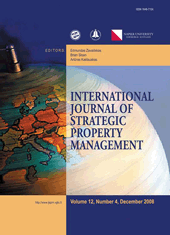Developing Capacities for Disaster Risk Reduction in the Built Environment: Capacity Analysis in Sri Lanka
Developing Capacities for Disaster Risk Reduction in the Built Environment: Capacity Analysis in Sri Lanka
Author(s): Kanchana Ginige, Richard Haigh, Dilanthi AmaratungaSubject(s): Economy
Published by: Vilnius Gediminas Technical University
Keywords: Built environment; Capacity development framework; Capacity gaps; Disaster risk reduction; Sri Lanka
Summary/Abstract: This paper introduces a framework for capacity development for disaster risk reduction in the built environment. The framework was developed as a part of an ongoing research which aims to strengthen the capacities of individuals and institutions in the built environment to ensure that disaster risk reduction meets its mission and goals in a sustainable way. It is presented as a matrix that identifies four stages of capacity development against six groups of stakeholders in the built environment. The stages and the stakeholder groups were derived through a series of expert interviews and a comprehensive literature review. The four stages are named as Analysis, Creation, Utilisation and Retention. This paper in its latter sections focuses on the first stage, Analysis, and presents some of the initial findings of the research. Analysis attempts to capture capacity gaps in the relevant context in order to identify required capacity development. The study reviews literature on Sri Lanka and discusses such capacity gaps. Problems in the regulatory structure, deficiencies in necessary laws and regulations including problems in their implementation, and lack of required resources and skills have been identified as the major capacity gaps in the country.
Journal: International Journal of Strategic Property Management
- Issue Year: 14/2010
- Issue No: 4
- Page Range: 287-303
- Page Count: 17
- Language: English

